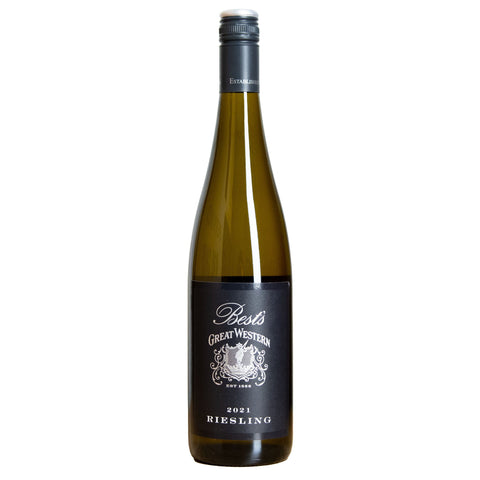
2021 Best's Great Western Riesling, Grampians, Victoria, Australia
Aromas of kaffir lime and nashi pear with a jasmine lift. Zesty citrus, crunchy red apple skin supported by a steely backbone.
ABOUT THIS WINE
A real insider’s wine, Great Western produces aromatic, flavorsome yet structured and spectacularly age-worthy Rieslings which stand confidently alongside their more famous South Australian cousins. RR127 and Pewsey Vale clones grown in the Concongella Creek and the Rhymney Vineyard sites (granite sub soils with red clay loam and granite/quartz gravels), this Riesling shows both intensity and finesse. Vines date back to the 1960s. Grapes are cold fermented in stainless steel tanks, retaining the fruit’s inherent aromatics and acidity.
ABOUT THIS PRODUCER
North-west of Melbourne in the region of The Grampians (formerly known as Great Western which is now a subregion), James Halliday describes the area as “quintessential Australian bush country, much of the slopes still covered with stringybark eucalypts”. Indeed, the old “great western” name harks back to the mid 19th century, a time when the vast expanse of western Victoria meant the gold rushes and endless get rich quick opportunities. But with the population influx into the western provinces, some say up to 20,000 miners were prospecting in Ballarat as early as 1853, other industries grew over time too. One of these was wine.
Henry Best, for whom Best’s Great Western is named, planted his first vines in the region as far back as 1866. A few decades later, the scotsman William Thomson bought property and planted vines at Rhymney to the south, adding the original Best’s vineyards to his holdings in 1920 upon Henry Best’s death. The Thomson family continue to own and operate Best’s Great Western today, making it one of the few historic Australian wineries to remain non-corporatized.
Best’s original plantings included 48,000 vines and many exist today, pre-phylloxera and on their original rootstock. Soils range from hard setting silt over clay to friable clay loams. In general the soils and vineyards are low yielding and retain moisture very well, essential in a region with limited rainfall. The altitude of the Grampians region results in lower than average temperatures than that of the Central Victorian wine regions to the east. The climate of the region is Mediterranean with breezes from the Southern Ocean providing a cooling influence during summer. The region is especially well suited to later ripening red varieties, particularly Shiraz.
Best’s wines are made by Justin Purser, graduate of Adelaide University and has worked in Australia (Primo Estate Wines) and overseas (Peregrine Wines in New Zealand; Azienda Brezza Giacamo e Figli in Barolo; and Domaine de Montille in Volnay). There are three ranges: Icon, Concongella and Great Western. The Icon range represents the old 1860s dry grown vines, such as the Old Vine Pinot Meunier and ‘Bin 0’ Shiraz; Concongella are special wines that are made as a result of a particular vintage, innovative cellar or winemaking techniques; and the Great Western Range represents Best’s classic, medium-bodied style of wines including Shiraz and Riesling.
